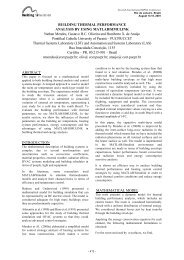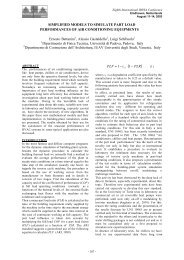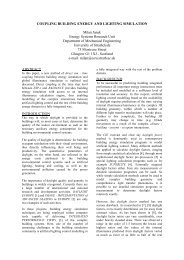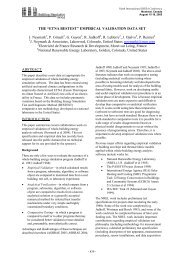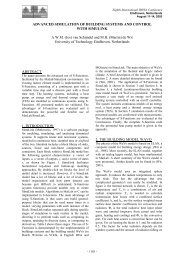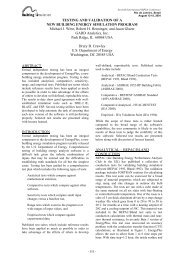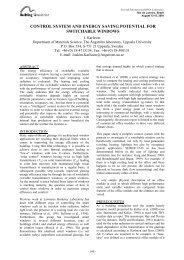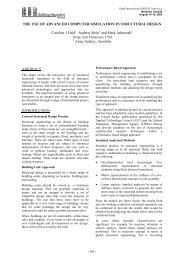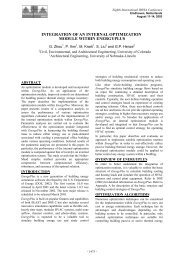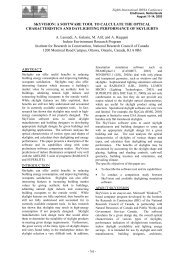Simulation In Control System Sensor Location Design - ibpsa
Simulation In Control System Sensor Location Design - ibpsa
Simulation In Control System Sensor Location Design - ibpsa
Create successful ePaper yourself
Turn your PDF publications into a flip-book with our unique Google optimized e-Paper software.
]C[TemperatureProceedings of Building <strong>Simulation</strong> 2011:12th Conference of <strong>In</strong>ternational Building Performance <strong>Simulation</strong> Association, Sydney, 14-16 November.Verification of the modelTo verify the model functionality, it was necessary toperform the verification model on the basis of themeasurements. Measurements were carried out in thewinter 2010 as a part of student assignment.. Thismeasurement consisted of outdoor air temperature,humidity, solar radiation intensity, speed and winddirection and indoor air temperature in the referenceroom (office "A226"). Unfortunately, it was notpossible to measure operative temperature at thattime due to technical and operational circumstances(the room was occupied and cooperation with userwas not the best). It was necessary to acceptassumption that in case that the simulated results ofindoor air temperature will match the measuredvalues, it is possible to expect that there is no majormistake in the model.Figure 2 Comparison of the measured and in themodel used outdoor air temperatureMeasured outdoor temperatures were used as input tothe model. Due to differences between measurementtime steps and that required by the model,interpolation was required. The comparison is shownin Figure 2.22.021.821.621.421.221.020.820.620.420.220.0<strong>In</strong>door Air Temperature(15.12.2010)Measured <strong>In</strong>door TemperatureTime<strong>In</strong>door Temperature of ESP -rFigure 3 Comparison of the indoor air temperaturewith measured valuesFigure 3 shows that the program ESP-r expected tomaintain the desired indoor temperature, but in factthere was a decrease or increase in temperature.Actually, the measured temperature rose and fell inthe range of ±0.2 °C around the temperature selectedin simulation programme. This difference wasevaluated as acceptable and model in the airtemperature domain has been considered assatisfactory.<strong>Simulation</strong><strong>In</strong> the next step, the work continued with thesimulation. The question to be solved at this pointwas how to deal with the limited possibilities of ESPrin terms of operative temperature calculation andrequirement for more detailed view on thetemperature distribution in the room to get data forthe next experiments and decisions related to optimalsensor placement.ESP-r enables to calculate operative (in the programcalled resulting) temperature t o in one point, which islocated in the ideal centre of the room. This value issufficient for building energy performancecalculations, but not for our task, where we wanted toinvestigate non-uniformity of the operativetemperature within the room. To simulate this, weused the MRT (mean radiant temperature, t MRT )module of ESP-r (Kabele, Krtková, 2001). Thismodule enables to simulate MRT in selected and bycoordinates specified positions of the room. Theproblem is that MRT gives information only aboutsurface temperatures “visible” from a given point andno information about operative temperature, which isdefined as “a uniform temperature of a radiantlyblack enclosure in which an occupant wouldexchange the same amount of heat by radiation plusconvection as in the actual non-uniform airtemperature” . To get operative temperature indifferent points of the room, we used the basicdefinition of operative temperature expressed byequation (1):to=( h ⋅t+ h ⋅t)cacrh + hrMRT[ °C](1)According to (Government regulation 523, 2002) forair movement velocities in the room up to 0.2 m/s itis possible to simplify the equation (1) into equation(2), based on assumption, that within low airvelocities, convective and radiant heat transfercoefficients are equal:t( t + t )a MRTo=2[ ° C](2)- 2575 -



